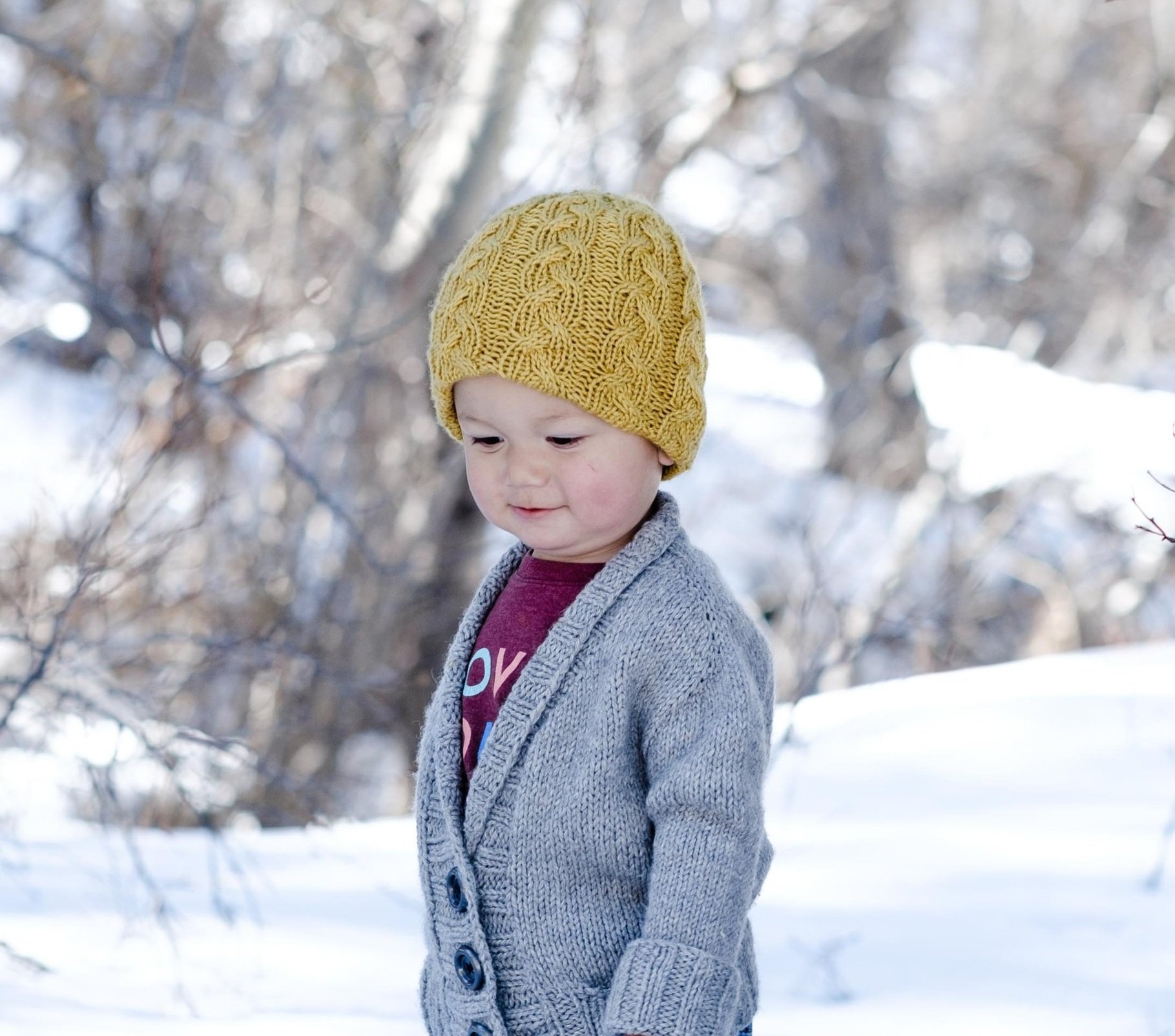Everyday Cables Baby Beanie – Free Knitting Pattern
The Everyday Cables Beanie is a double layered beanie that features stockinette on one side and cables on the other and is completely reversible. It can also be made to have a brim that folds up for extra warmth and coziness.
A beanie is a must-have when the snow starts falling. I wanted a versatile beanie that I would want to wear everyday. This beanie definitely checks all the boxes.
Initially, my plan for this beanie was a complicated 2-colored stranded work, but the 2 colors made the beanie a bit bulkier than I wanted. So after frogging and starting again, it quickly shifted to a simple cable design which made it even better!
BUT I wanted to make it even more versatile and even better! So I extended the brim on the second beanie so it could be folded up. The perk of this is that the other side of the beanie can be shown off (e.g. cables on a stockinette beanie or vice versa). This added a whole new dimension to the beanie.
The newborn size is available for FREE on this blogpost (scroll down). The paid version of the pattern comes sized for baby, child, adult small and adult large so the whole family can wear it! The simple cable design is perfect for the adventurous beginner who is ready to level-up their knitting skills. The beanie is made seamlessly in one piece, so the only finishing that is required is the beginning and the end. It is also easy to incorporate other colors and make it truly your own.
Purchase the Everyday Cables Beanie in my Ravelry or Payhip store for a beautifully formatted PDF with cables and decreases in chart and written format.
EVERYDAY CABLES BEANIE
Beanies are a must-have accessory in the winter weather where I live. The biggest decision is: double-brimmed or double layered? But why not both?
The Everyday Cables Beanie is a double layered beanie that features stockinette on one side and cables on the other and is completely reversible. There are instructions to keep it as a simple double layered beanie or to extend it so the brim can be folded up. The brim adds a little pizzazz by showing off the other side of the beanie. If you don’t need the extra layer the brim provides, it can be worn as a slouchy beanie. My favorite way to wear my beanie is with the cabled brim folded over on the stockinette side.
PATTERN INFORMATION
This beanie is made in one piece, starting at the stockinette side then moving onto the cabled side.
Shown in sizes Child Version 1 (mustard yellow) and Adult S Version 2 (gray).
Sizing listed in pattern will be in Baby (Child, Adult S, Adult L)
The beanie is meant to be worn with 1-2″ / 2.5-5cm negative ease. This means the finished size of the beanie should be 1-2″ / 2.5-5cm smaller than the head of the wearer.
FINISHED MEASUREMENTS
Version 1 (without brim):
Baby: 14″ circumference x 8″ long/ 34.5cm x 20.5cm
Version 2 (with brim):
Baby: 14″ x 10″/ 34.5cm x 25cm
This beanie is meant to be worn with 1″-2″ (2.5 cm-5 cm) negative ease.
SUGGESTED NEEDLES
US 8 (5 mm) double-pointed needles or preferred method for small circumference knitting.
US 9 (5.5 mm) double-pointed needles or preferred method for small circumference knitting.
GAUGE
18.5 sts x 26 rounds = 4” (10 cm) with US 8 (5 mm) in stockinette.
YARN
Version 1 (without brim):
130 (170, 230, 270)yards / 120 (150, 210, 250)m
Version 2 (with brim):
180 (220, 290, 330)yards / 160 (200, 270, 300)m
Yarn Used:
Cloudborn Superwash Merino Worsted Twist. (Worsted Weight; 100% Superwash Merino Wool; 100g; 220 yards/ 201 meters). 1 skein. Color used: Maize heather (Child); Gray (Adult L).
NOTIONS
1 – Stitch marker
Darning needle
STANDARD ABBREVIATIONS
[ ]: repeated section
1/1 LC: 1 over 1 left cross: Slip next 1 stitches to cable needle, hold at front of work, K1, then K1 from cable needle
1/1 RC: 1 over 1 right cross: Slip next 1 stitches to cable needle and hold at back of work, K1, then K1 from cable needle
1/2 LC: 1 over 2 left cross: Slip next 1 stitches to cable needle, hold at front of work, K2, then K1 from cable needle
2/1 RC: 2 over 1 right cross: Slip next 2 stitches to cable needle and hold at back of work, K1, then K2 from cable needle
2/2 LC: 2 over 2 left cross: Slip next 2 stitches to cable needle, hold at front of work, K2, then K2 from cable needle
2/2 RC: 2 over 2 right cross: Slip next 2 stitches to cable needle and hold at back of work, K2, then K2 from cable needle
dpn(s): double pointed needles
inc(s): increase(s)(ing)
kfb: knit front and back
k: knit
k2tog: knit 2 sts together
st(s): stitch(es)
p: purl
Rnd: round
PATTERN INSTRUCTIONS
SIDE ONE
Set- up: With smaller double pointed needles, cast-on 8 sts, (2 sts on each needle).
Join into round, being sure stitches are not twisted.
INC PORTION
Note: As you work the INC PORTION, switch to circular needles as needed.
Rnd 1: k all sts.
Rnd 2 (inc rnd): [kfb]. (16 sts)
Rnd 3: k all sts.
Rnd 4 (inc rnd:) [k1, kfb]. (24 sts)
Rnd 5: k all sts.
Rnd 6 (inc rnd): [k2, kfb]. (32 sts)
Rnd 7: k all sts.
Rnd 8 (inc rnd): [k3, kfb]. (40 sts)
Rnd 9: k all sts.
Rnd 10 (inc rnd): [k4, kfb]. (48 sts)
Rnd 11: k all sts.
Rnd 12 (inc rnd): [k5, kfb]. (56 sts)
Rnd 13: k all sts.
Rnd 14 (inc rnd): [k6, kfb]. (64 sts)
Rnd 15: k all sts.
Total sts on needle: 64
Version 1 (without brim): Work in stockinette stitch until the beanie measures 8”/ 20.5cm or length preferred from top of beanie.
Version 2 (with brim): Work in stockinette stitch until the beanie measures 10”/ 25.5cm or length preferred from top of beanie.
SIDE TWO
CABLE PATTERN
Switch to larger needles
Rnd 1 – Rnd 3: [p1, k6, p1]
Rnd 4: [p1, 2/2 LC, k2, p1]
Rnd 5 – Rnd 7: [p1, k6, p1]
Rnd 8: [p1, k2, 2/2 RC, p1]
Version 1 (without brim): Work Cable Pattern until beanie measures 6″ / 15.5cm or 2″/ 5cm shorter than Side 1, ending on Rnd 8 of Cable Pattern.
Version 2 (with brim): Work Cable Pattern until beanie measures 8″/ 20.5cm or 2″/ 5cm shorter than Side 1, ending on Rnd 8 of Cable Pattern.
DEC PORTION
Note: As you work the DEC PORTION, switch to double pointed needles as needed.
Rnd 1: [p1, k6, p1].
Rnd 2 (dec rnd): [p1, k2tog, k4, p1]. 56 (63, 70, 77)
Rnd 3: [p1, 1/2 LC, k2, p1].
Rnd 4 (dec rnd): [p1, k2tog, k3, p1]. 48 (54, 60, 66)
Rnd 5: [p1, k1, 2/1 RC, p1].
Rnd 6 (dec rnd): [p1, k2, k2tog, p1]. 40 (45, 50, 55)
Rnd 7: [p1, 1/1 LC, k1, p1].
Rnd 8 (dec rnd): [k2tog, k2, p1]. 32 (36, 40, 44)
Rnd 9: [k1, 1/1 RC, p1].
Rnd 10 (dec rnd): [k2, k2tog]. 24 (27, 30, 33)
Rnd 11: [1/1 LC, k1].
Rnd 12 (dec rnd): [k1, k2tog]. 16 (18, 20, 22)
Rnd 13: [k all sts].
Rnd 14 (dec rnd): [k2tog]. 8 (9, 10, 11)
FINISHING
Cut yarn leaving a 10″/ 25.5cm tail. Using a darning needle, take the tail through all sts pulling taut to close hole.
Weave in the ends and gently block to measurements.
Purchase the Everyday Cables Beanie in my Ravelry or Payhip store for a beautifully formatted PDF with cables and decreases in chart and written format.







